rac·on·teur
/ˌrakˌänˈtər/
Noun
A person who tells anecdotes in a skillful and amusing way.
Synonyms
narrator – storyteller
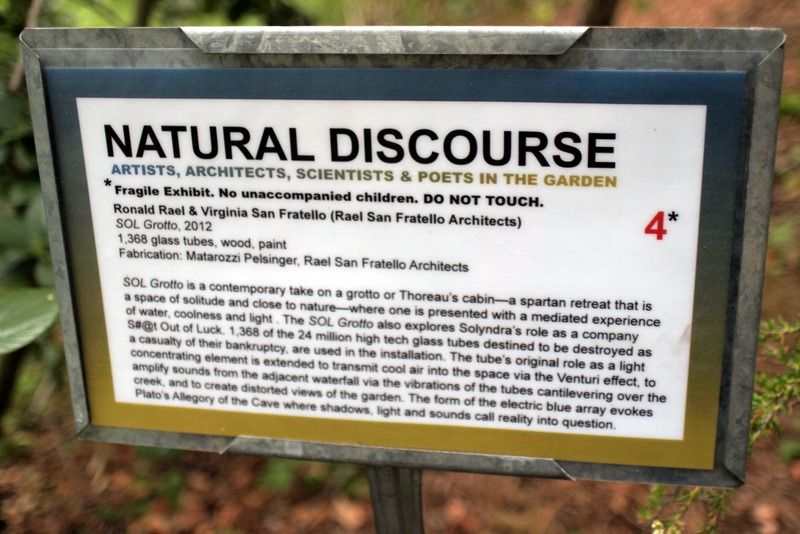
Way back in January I breezily announced “ambitious plans to produce transcripts of the lectures” given by the illustrious group of artists and scientists who participated in the “Natural Discourse” symposium hosted by the University of California Botanical Garden at Berkeley, curated by artists Shirley Watts and Mary Ann Friel. In the interim I’ve learned that verbatim transcripts are lifeless things, so I’ve been trying to carve off small segments of the lectures that can most clearly be supported by whatever photos I have or can easily find. (The first in this contemplated series was “cochineal.”)
To set the stage for an excerpt from the lecture by Ronald Rael, of Rael San Fratello Architects, first a few photos of the source of inspiration and instigator of this natural discourse, the botanical garden itself.

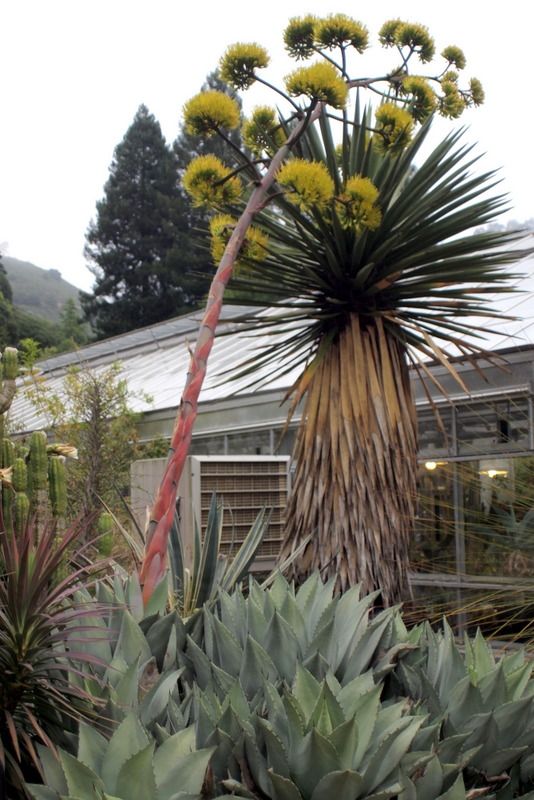
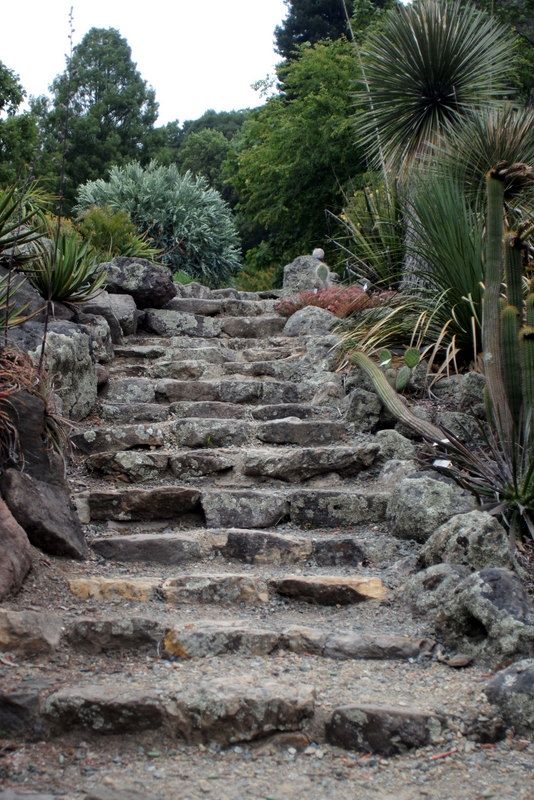
The yuccas dotted throughout the botanical garden are major characters in our story.
As I wrote here, much to the surprise of all involved, the work that Rael San Fratello Architects created for Natural Discourse, (using discarded photovoltaic tubes engineered by the bankrupt solar energy company Solyndra), was the unlikely fuel for a media firestorm that was enthusiastically fanned into partisan flames by local and national media.
Mr. Rael addresses the Solyndra controversy later in the lecture. For now, the following is an excerpt on Prada Marfa from the presentation by Mr. Rael on January 11, 2013, entitled “Material Provenance.” Just as with the Solyndra/Sol House project, Prada Marfa took a series of unforeseen and bizarre twists and turns.
“My name is Ronald Rael. My partner’s name is Virginia San Fratello. I teach at Berkeley and she teaches at San Jose.
And one thing that we discovered when working here is that one of the fundamental ideas behind the garden itself is that all of the plants have this kind of provenance as well. Each of these little name tags tells where the plant came from and what date. So as you walk around the garden, you realize that these plants, they just don’t exist here. They have a story behind them. And that story is what we think is incredibly meaningful. And it’s the story today that I want to tell you about in a handful of projects.
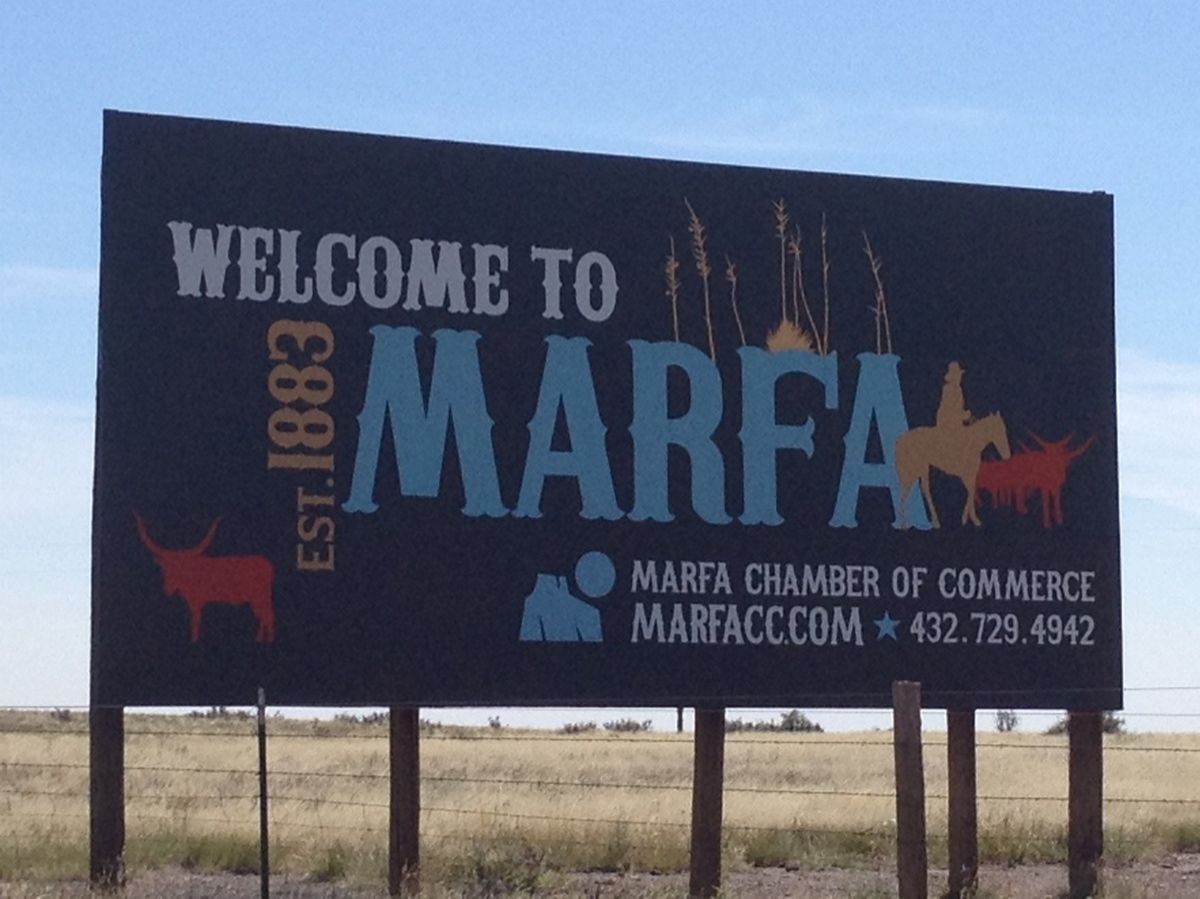
Image found here
“The first project I want to talk to you about is called Prada Marfa. It’s a project that we did in 2004. When we started this project, I actually didn’t know what Prada was. I knew what Prada was, but I didn’t really know what Prada was. And I don’t know if all of you know about Marfa, but Marfa is a small town in the West Texas desert that was made famous partly by artist Donald Judd, a minimalist artist.
“When we began working on this project, another thing that I discovered about the region is that there was a traditional shoe made out of the yucca plant. And the yucca thrives in this environment, in the West Texas desert, but that tradition of making these kinds of shoes doesn’t really exist anymore. But what exists is a kind of culture of people moving across the desert, traveling north in search of a better life. And we built this project about 20 miles from the U.S./Mexico border. And so during construction, we often saw helicopters pick up people traveling in the desert. And one thing that we learned is that, people traveling in the desert, shoes wear out after traveling hundreds of miles, and they stuff their shoes with yucca plants. And so there was this strange juxtaposition between the wealth that existed in the region, the poverty that existed in the region, the disappearing traditions, and they all came together at this weird border between these two worlds.
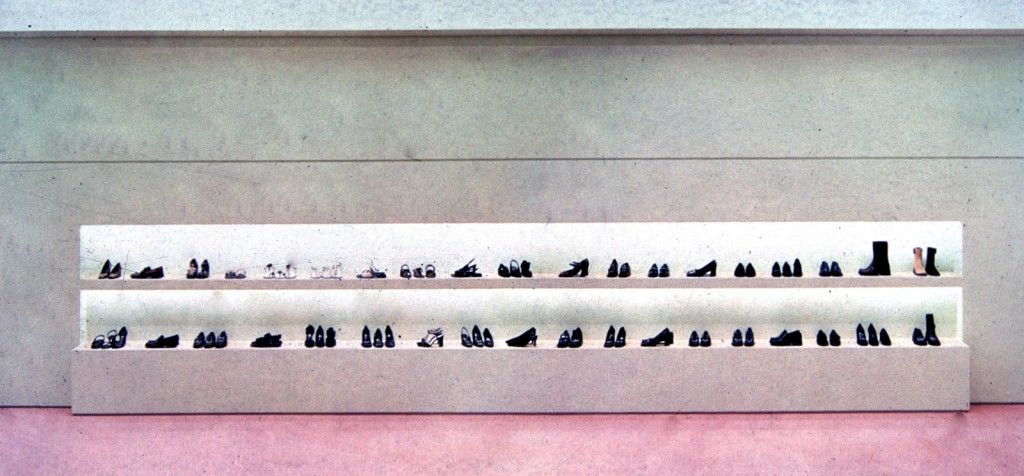
“And so the project is partly based on a very famous photograph by Andreas Gursky called “Prada.”
“So when we constructed this Prada, we said, well, the traditional building material in the region is mud, and so let’s construct this version of Prada out of mud to kind of heighten this kind of juxtaposition between these two worlds. So we fashioned this installation of a fake Prada store in the middle of the desert, which is one of the most expensive clothiers in the world, out of one of the most inexpensive and humble materials.

“And the construction of the mud, we didn’t put it in a mud mortar, but we actually based it in a cement mortar. And this was something that Donald Judd used. And, again, it’s a juxtaposition between the industrial and the non-industrial worlds, conflating it at this very moment, with the idea that in time the building would erode and expose these kinds of juxtapositions even in its decay.
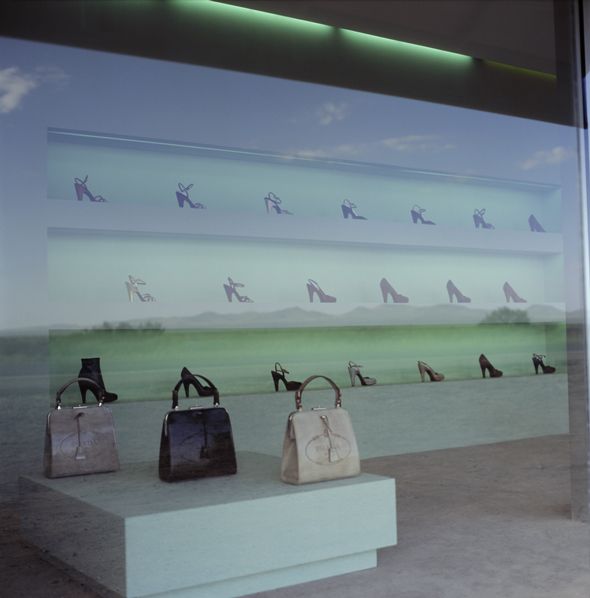
“So this is the building, and it holds a 2005 line of purses and shoes. And even in its construction, these kinds of dichotomies were present in the workers that would come from Ojinaga, Mexico, to build the project and then in the photo shoots of the professional photographers that chose this particular person in Boyd Elder, who is a fifth-generation rancher, who lives closer than anybody else to the Prada Marfa store.
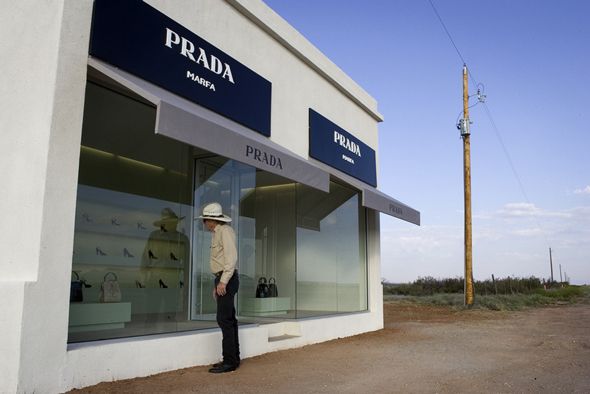
“But even Boyd had an amazing provenance. What we learned about Boyd is that in the 1960s he left his family ranch to go to LA to be an artist and hang out with the Eagles, and he’s the painter for the original Eagles’ covers. And so it’s the provenance of stories that makes projects interesting.
“So the New York Times wrote a quote from one of the funders of the project, Yvonne Force: ‘We loved this proposal for many reasons. We loved the idea of the piece being born on Oct. 1 and that it will never again be maintained. If someone spray-paints graffiti or a cowboy decides to use it as target practice or maybe a mouse or a muskrat makes a home in it, 50 years from now it will be a ruin that is a reflection of the time it was made.’

“And so there was this idea that we just let it go. We had this grand party in the middle of the desert. A band came and played. There was wine, cheese. Even members of Prada Foundation flew in to see this.
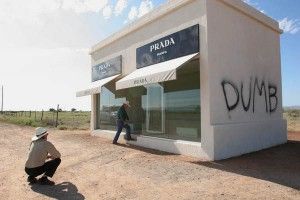
image found here
“And the next morning we all woke up, and someone had tied a chain to the front of the facade, pulled off the facade, and spray-painted “dumb” and all these things on it. It immediately went into preservation mode. And people now today peel-out on it and shoot it and do all sorts of strange things, but immediately it’s been fixed again in kind of this perfect state. So, again, there’s this irony between the intentions of the work and what actually happens to the work.
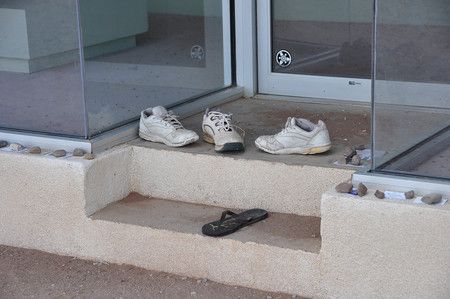
image found here
“Another amazing thing that’s happened to the work is it’s become a shrine for left-over shoes. And it’s so far away from anything, but when people are driving out there they decide to leave their shoes as some sort of effigy on the project. And so they are also cleaning up hundreds of shoes constantly on the project. Boyd Elder, the cowboy, he’s the official caretaker of the project. And so today it’s perfectly preserved.

“This is the most recent photo, with Beyonce jumping in front of it, and it’s become kind of an icon in the middle of the desert, whose image we can’t let go of.”

There is a reason that artists are artists..not bound by the mundane, imaginative, open to the paradigm shift. I mean, who else would ever think of doing something like this ? And I can’t help thinking of the irony of a shrine to designer shoes installed so near to the crushing poverty of the US/Mexico border towns.
Kathy, I’m vigorously nodding in agreement. I think most visitors to Prada Marfa get that it was never intended as a shrine to designer shoes…well, maybe with the exception of Beyonce 😉
…and then I got to thinking about the people leaving shoes–are they compelled to do this because of the gravity pull of the art, or are they deliberately joining in ? Even the dude who painted ‘dumb’ on the wall has become a(probably unwilling) participant in the installation.
Thank you.
Now this is thought provoking and interesting. I love how some people’s minds work. So totally and completely outside the ‘box’.
Loree, glad I could return the favor — you give such a good read every single day.
Deanne, there’s rumors there may yet be another similar symposium. I hope so.
Wonderful story, thanks!
Could have named the puppies “Prada” and “Marfa”. Lost opportunity, that.
Really enjoyed the background on this, I’ve never heard reported…and related to the noble yucca!
Especially seeing how it was built from adobe…I had no idea. A humble material, but for over 20 years in NM, probably the most expensive walls to build homes out of anymore…